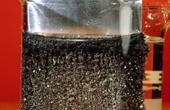Lead

Such a chemical element as lead, is a poison of high toxicity. Its natural content in most plant and animal products usually does not exceed 0.5-1.0 mg / kg. The largest amount of lead is found in predatory fish( in tuna, for example - up to 2.0 mg / kg), mollusks and crustaceans( up to 10 mg / kg).
In most cases, an increased content of lead is observed in canned foods, which are in the so-called precast tin. This type of packaging is a tin can, which is soldered to the side and to the cover by solder, containing in its composition a certain amount of lead. In some cases, there is a poor-quality soldering, as a result of which spatter of solder is formed, from which the additional coating of the cans with a special varnish does not always help. In some rather rare cases, there is accumulation in cans from this container( especially with prolonged storage) to 3 mg / kg and even higher than lead, which is a health hazard. Products in such a tin container should not be stored for more than 5 years.
Combustion of leaded gasoline also causes severe lead contamination. Such a chemical compound as tetraethyl lead is added to gasoline in an amount of about 0.1% in order to increase the octane number. This substance is much more volatile and toxic than lead itself and its various inorganic compounds. Tetraethyl lead readily enters the soil and causes contamination of plant and animal foods grown on it. It is for this reason that the products grown along motorways contain an increased amount of lead, and depending on the traffic intensity, this dangerous zone can stretch from 10 to 500 m. In this zone, it is recommended to plant only forest species or grow various forage crops. Due to the neglect of these recommendations and the planting of fruit trees along the roads, they eventually receive lead-contaminated fruits.
With respect to product pollution control, excellent results have been achieved in Denmark. For several years, the use of leaded petrol in cars has been banned in this country, which in turn led to a reduction in the natural level of lead in basic vegetables( such as potatoes, carrots and onions) by 2-3 times.
Used materials:
Shilov VN, Mits'yo VP"Healthy food"
